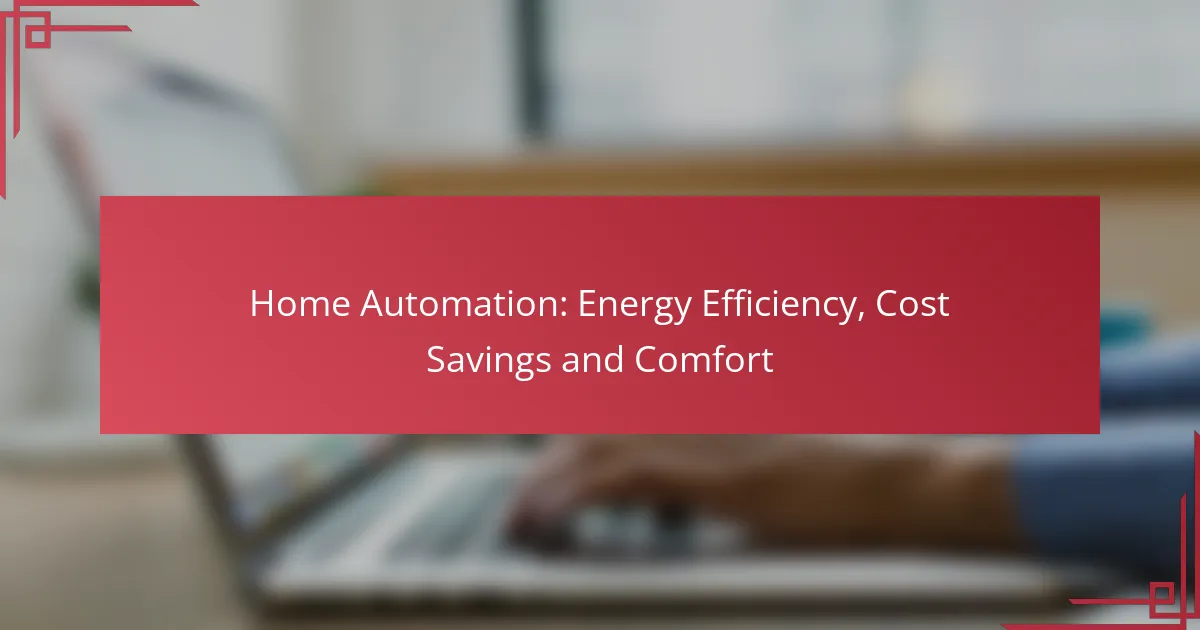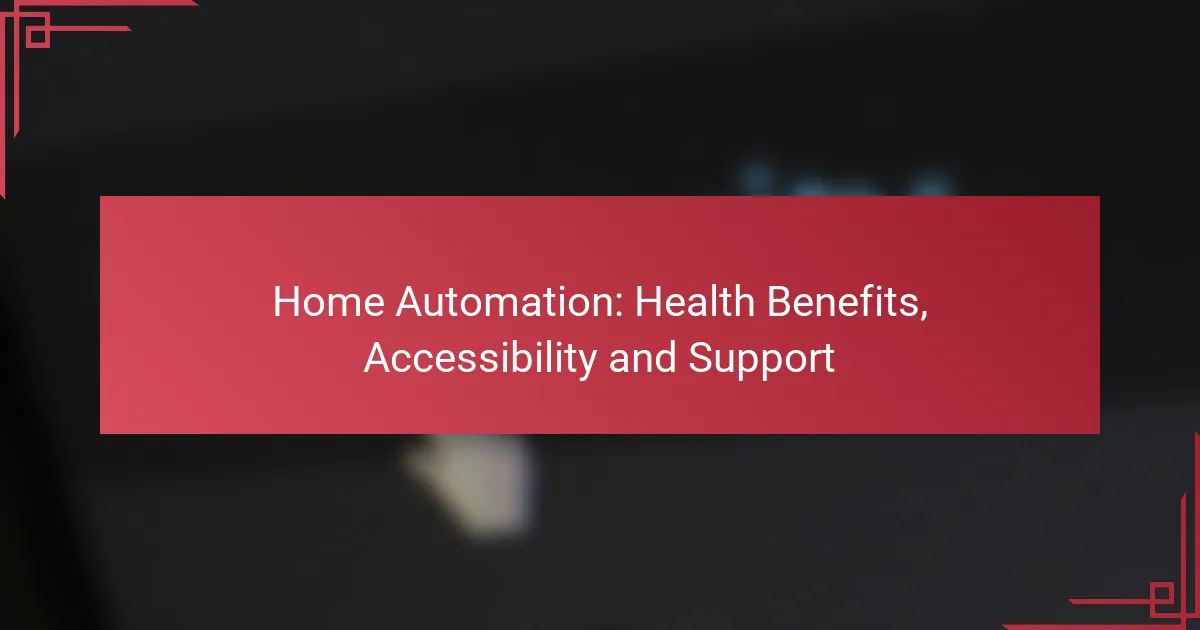Home automation is transforming the real estate landscape by significantly boosting property values and appealing to modern buyers. As consumers increasingly prioritize convenience, energy efficiency, and security, the adoption of smart technologies is on the rise, reflecting a shift towards more connected living environments. Additionally, urban development plays a crucial role in this trend, fostering an ecosystem that encourages the integration of innovative solutions to meet the demands of contemporary living.
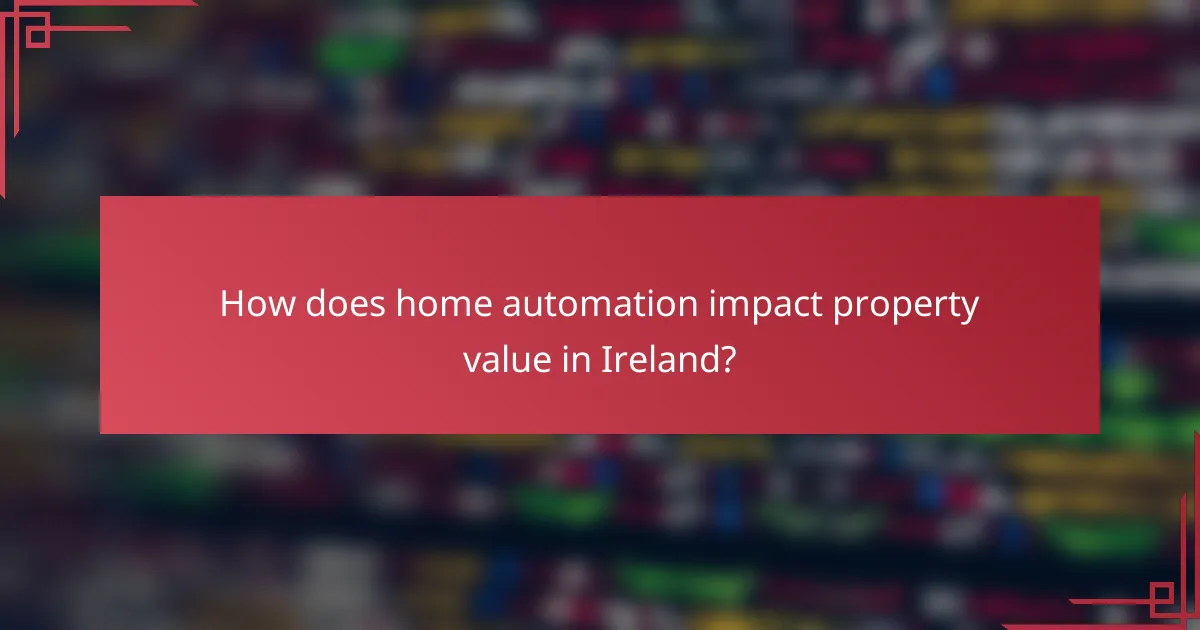
How does home automation impact property value in Ireland?
Home automation can significantly enhance property value in Ireland by making homes more attractive to buyers. Features such as smart lighting, heating systems, and security devices not only improve convenience but also contribute to energy efficiency and safety, which are increasingly prioritized in the real estate market.
Increased market appeal
Homes equipped with automation technologies tend to attract more potential buyers, as these features offer modern conveniences that align with contemporary lifestyles. Smart home systems allow for remote control of various functions, making properties more appealing to tech-savvy individuals.
In Ireland, properties with integrated home automation can see a price increase of around 5-10% compared to similar homes without these features. This added value is particularly evident in urban areas where demand for modern living solutions is high.
Energy efficiency savings
Home automation systems can lead to substantial energy savings, which is a key consideration for many buyers. Smart thermostats, automated lighting, and energy-efficient appliances help reduce utility bills, making homes more economical to maintain.
In Ireland, homeowners can expect energy savings of approximately 20-30% with the implementation of smart technologies. This not only lowers living costs but also appeals to environmentally conscious buyers looking for sustainable living options.
Enhanced security features
Automated security systems provide homeowners with peace of mind, which is a significant selling point. Features such as smart locks, surveillance cameras, and motion sensors can be monitored remotely, offering enhanced protection against intruders.
In the Irish market, properties with advanced security features are often viewed as safer investments. Buyers are willing to pay a premium for homes that offer these technologies, as they contribute to a sense of safety and well-being.
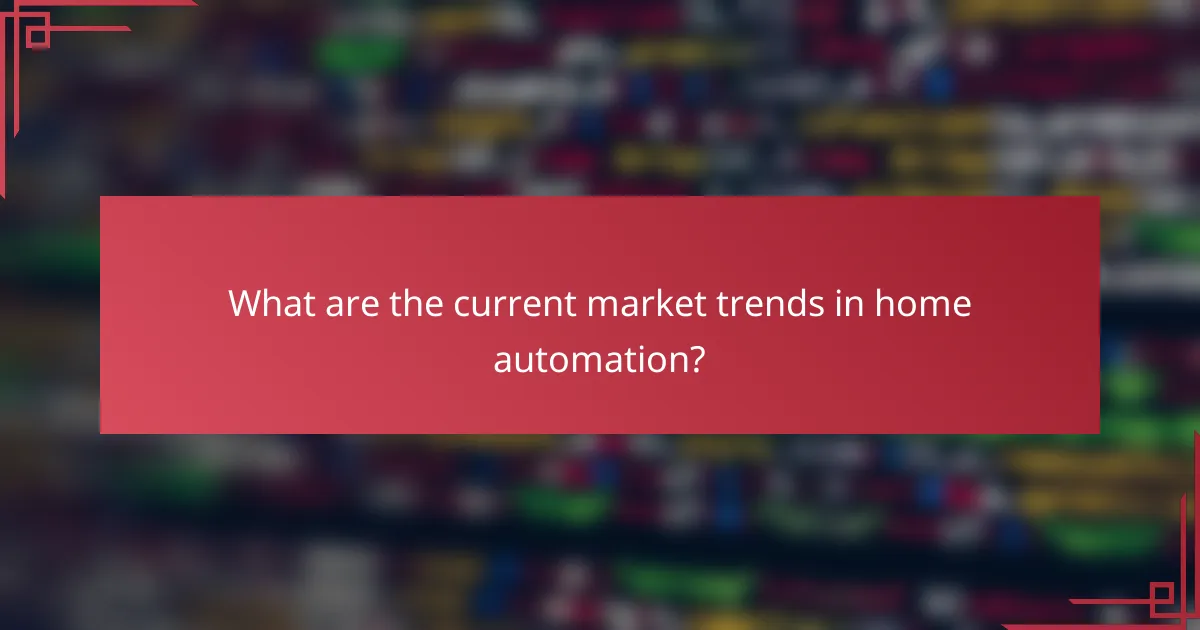
What are the current market trends in home automation?
The current market trends in home automation indicate a significant increase in consumer adoption of smart technologies, driven by convenience, energy efficiency, and enhanced security. Homeowners are increasingly investing in automated systems that integrate seamlessly into their daily lives, reflecting a shift towards more connected living environments.
Growth in smart home devices
The growth in smart home devices is evident as more households incorporate technologies like smart thermostats, security cameras, and voice assistants. Estimates suggest that millions of new devices are sold annually, with a notable increase in demand for energy-efficient products.
Homeowners should consider compatibility when selecting devices, ensuring they can work together within a unified system. Popular brands often provide ecosystems that allow for easy integration, enhancing user experience.
Integration with renewable energy sources
Integration with renewable energy sources is becoming a crucial aspect of home automation, as homeowners seek to reduce energy costs and environmental impact. Systems that manage solar panels and energy storage solutions are increasingly common, allowing users to optimize energy use and maximize savings.
When considering integration, homeowners should evaluate local incentives for renewable energy installations, such as tax credits or rebates, which can significantly offset initial costs. This trend not only supports sustainability but can also enhance property value.
Rise of subscription-based services
The rise of subscription-based services in home automation offers users ongoing access to advanced features and support. Many companies now provide monthly or yearly plans that include software updates, cloud storage for security footage, and premium customer service.
Homeowners should weigh the benefits of these services against their long-term costs. While subscriptions can provide enhanced functionality, it’s essential to assess whether the ongoing fees align with personal budgets and usage needs. Evaluating different service tiers can help in making an informed choice.
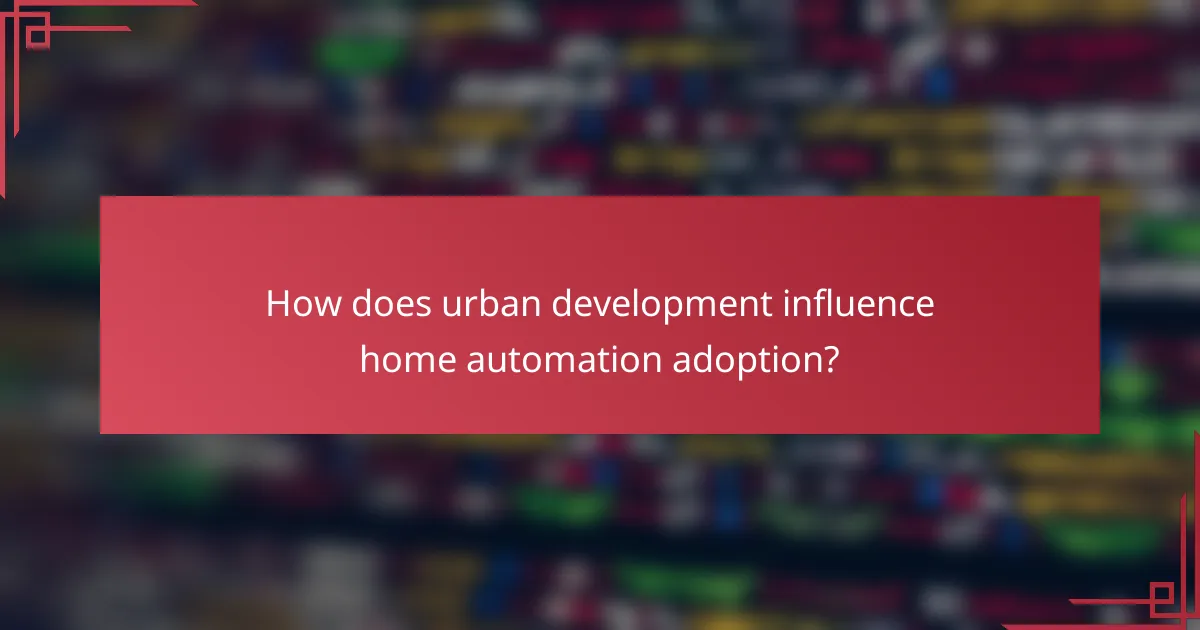
How does urban development influence home automation adoption?
Urban development significantly impacts home automation adoption by creating an environment that encourages technological integration. As cities evolve, the demand for smart solutions increases, driven by the need for efficiency, sustainability, and enhanced living standards.
Smart city initiatives
Smart city initiatives are programs designed to integrate technology into urban planning and management. These initiatives often include the deployment of IoT devices, smart grids, and data analytics to improve city services and infrastructure. Cities that prioritize smart technologies typically see higher rates of home automation adoption, as residents become accustomed to connected living.
For instance, cities like Barcelona and Singapore have implemented smart lighting and waste management systems, which not only enhance city efficiency but also encourage homeowners to adopt similar technologies in their residences.
Infrastructure improvements
Infrastructure improvements play a crucial role in facilitating home automation. Upgraded utilities, such as high-speed internet and reliable power sources, are essential for the effective functioning of smart home devices. In urban areas, investments in broadband expansion and energy-efficient systems can lead to a more conducive environment for home automation.
For example, cities that invest in fiber-optic networks often experience a surge in smart home device adoption, as residents benefit from faster internet speeds that support multiple connected devices simultaneously.
Urban density and technology access
Urban density influences technology access, which in turn affects home automation adoption. In densely populated areas, residents are more likely to have access to advanced technologies and services, including smart home solutions. This concentration of technology can create a competitive market, driving prices down and increasing availability.
Additionally, urban areas often have better access to tech support and installation services, making it easier for homeowners to implement automation systems. However, it’s essential to consider that not all urban developments prioritize technology, and disparities may exist based on socioeconomic factors.
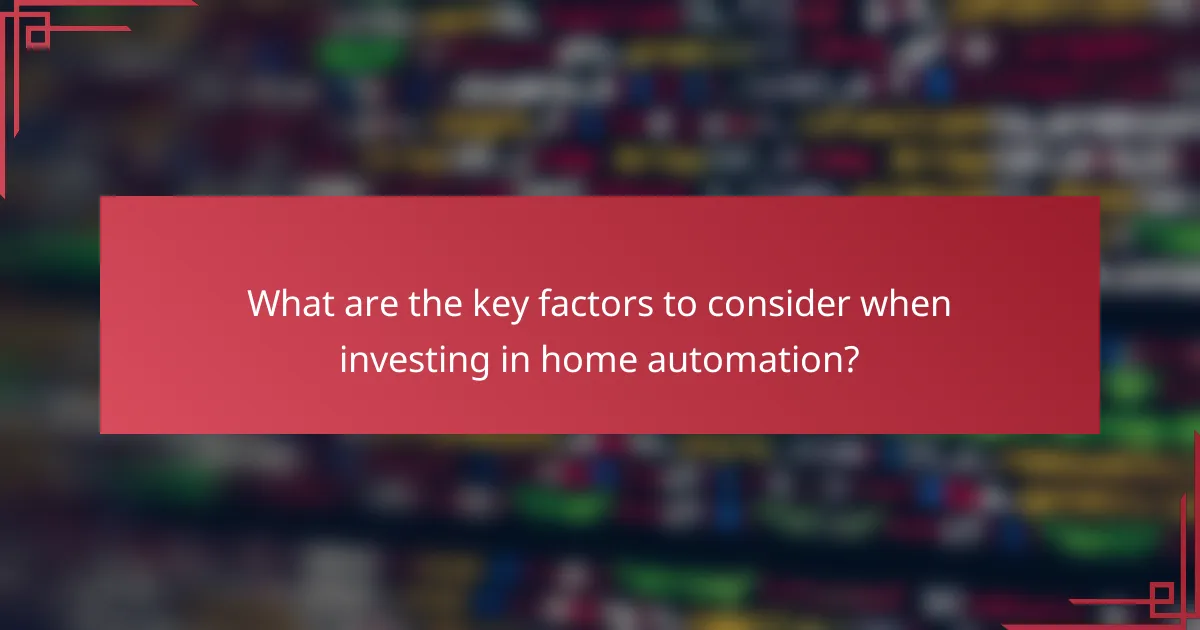
What are the key factors to consider when investing in home automation?
When investing in home automation, key factors include the initial cost, potential return on investment, compatibility with existing systems, and scalability for future upgrades. Understanding these elements helps ensure that your investment enhances property value and meets your long-term needs.
Cost vs. return on investment
The cost of home automation systems can vary widely, typically ranging from a few hundred to several thousand dollars, depending on the complexity and features. A well-planned automation system can yield a return on investment by increasing property value, often in the range of 10-20% in desirable markets.
To maximize returns, focus on features that appeal to buyers, such as energy efficiency, security enhancements, and convenience. Avoid over-customizing, as this can limit appeal to future buyers.
Compatibility with existing systems
Ensuring compatibility with your current home systems is crucial for a smooth integration of automation technologies. Many modern devices adhere to common standards like Z-Wave or Zigbee, which facilitate interoperability among various brands.
Before investing, assess your existing infrastructure, such as HVAC, lighting, and security systems. This evaluation helps identify which automation solutions can be seamlessly integrated without requiring extensive modifications or replacements.
Scalability for future upgrades
Scalability is an essential consideration when investing in home automation, as technology evolves rapidly. Choose systems that allow for easy upgrades or additions, enabling you to expand functionality without starting from scratch.
Look for modular systems that can grow with your needs, such as adding smart sensors or cameras over time. This approach not only protects your initial investment but also keeps your home current with technological advancements.
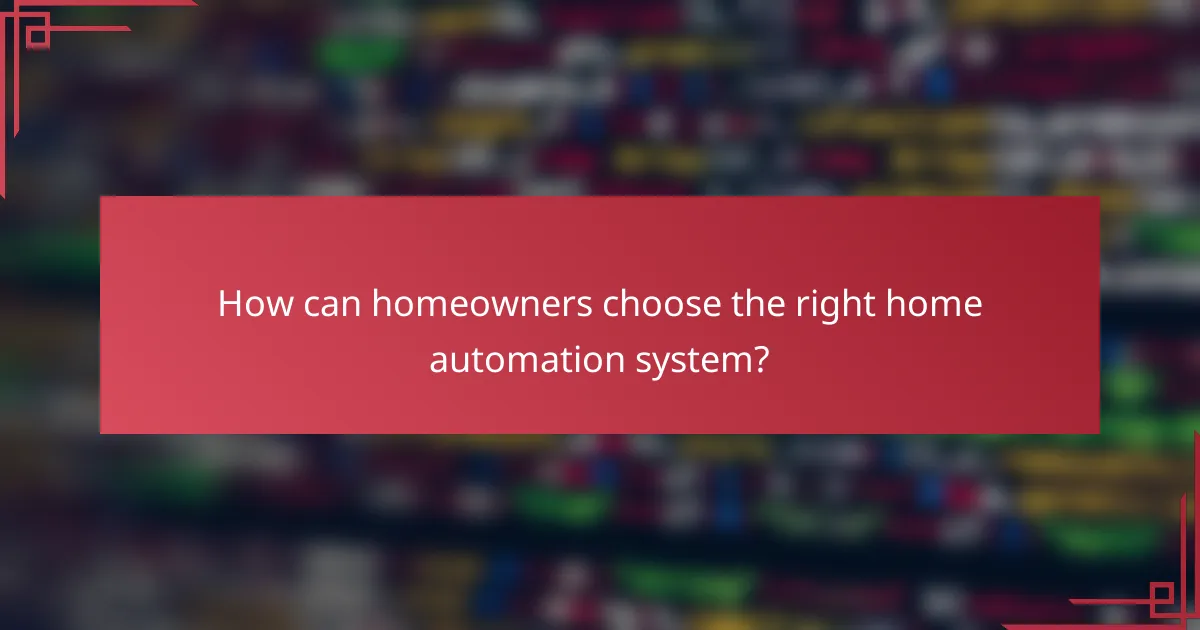
How can homeowners choose the right home automation system?
Homeowners can choose the right home automation system by assessing their specific needs, evaluating the reliability of brands, and comparing features and pricing. This approach ensures that the selected system aligns with their lifestyle and budget while providing the desired level of automation and control.
Assessing personal needs
Identifying personal needs is crucial when selecting a home automation system. Homeowners should consider what aspects of their home they want to automate, such as lighting, security, climate control, or entertainment systems. Prioritizing these needs helps narrow down options and ensures the system enhances daily living.
Additionally, homeowners should think about compatibility with existing devices and whether they prefer a centralized system or individual smart devices. Understanding the household’s routine can guide decisions on which features will be most beneficial.
Evaluating brand reliability
Brand reliability plays a significant role in the longevity and performance of a home automation system. Homeowners should research well-established brands known for quality and customer support. Reading reviews and checking ratings can provide insights into user experiences and product durability.
It’s also wise to consider brands that offer warranties and responsive customer service. A reliable brand can make troubleshooting easier and ensure that any issues are addressed promptly, minimizing disruptions to home automation.
Comparing features and pricing
When comparing features and pricing, homeowners should create a list of must-have functionalities versus nice-to-have options. This helps in evaluating different systems based on their specific requirements. Common features to consider include remote access, voice control, and integration with other smart devices.
Pricing can vary widely, so it’s essential to set a budget and look for systems that offer the best value for the desired features. Homeowners should also be aware of potential additional costs, such as installation fees or subscription services for advanced functionalities. Comparing multiple options can lead to better deals and more informed choices.
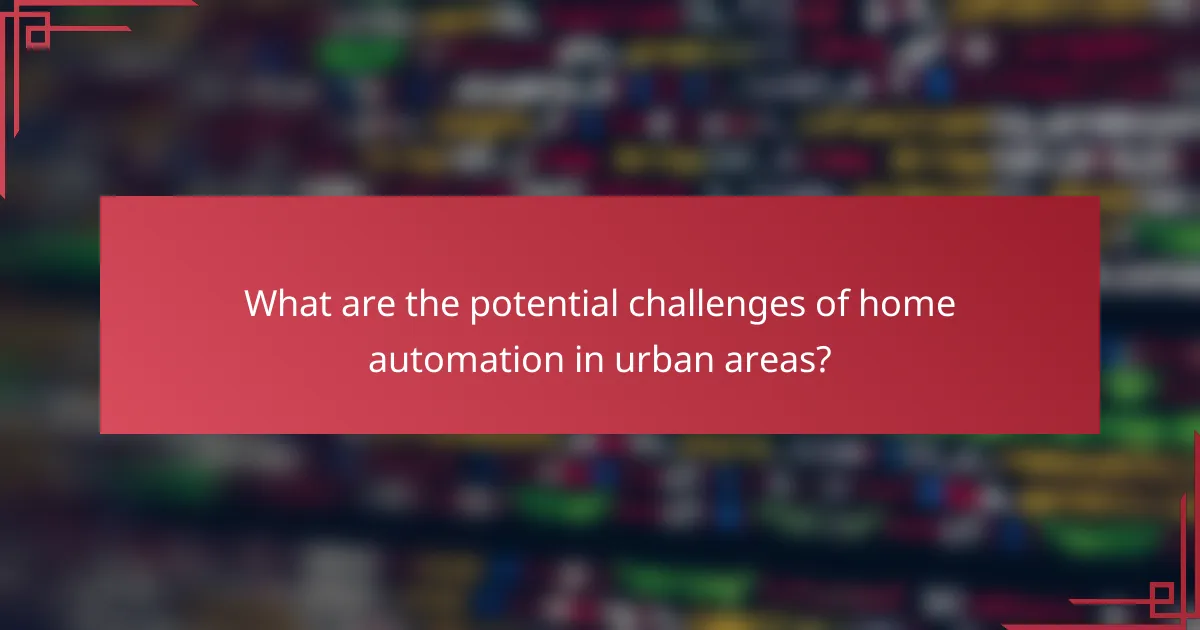
What are the potential challenges of home automation in urban areas?
Home automation in urban areas faces several challenges, including high installation costs, integration issues with existing infrastructure, and concerns over data privacy. These factors can complicate the adoption of smart technologies in densely populated settings.
High Installation Costs
The initial investment for home automation systems can be significant, particularly in urban environments where labor and materials may be more expensive. Homeowners may face costs ranging from a few hundred to several thousand dollars, depending on the complexity of the system and the number of devices installed.
To mitigate these costs, consider starting with essential devices such as smart thermostats or lighting systems before expanding to more comprehensive setups. This phased approach allows homeowners to spread out expenses and better understand their needs.
Integration with Existing Infrastructure
Integrating new automation technologies with older infrastructure can be challenging. Many urban homes may have outdated wiring or incompatible systems that hinder seamless connectivity. This can lead to additional expenses for retrofitting or upgrading existing systems.
Before investing in home automation, assess the current infrastructure and consult with professionals to identify potential compatibility issues. This can help avoid unexpected costs and ensure a smoother installation process.
Data Privacy Concerns
Urban residents often have heightened concerns about data privacy and security, particularly with smart devices that collect personal information. Vulnerabilities in these systems can lead to unauthorized access and data breaches, making homeowners wary of adopting such technologies.
To address these concerns, choose devices from reputable manufacturers that prioritize security features, such as encryption and regular software updates. Additionally, educate yourself on privacy settings and best practices to safeguard personal information while enjoying the benefits of home automation.

